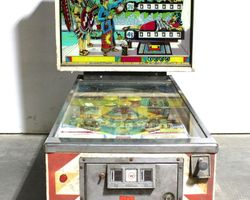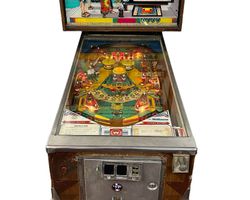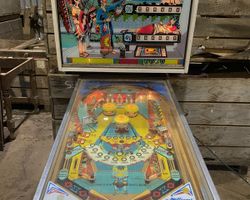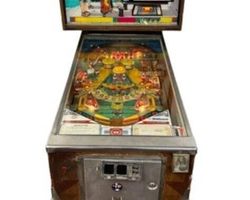Aztec
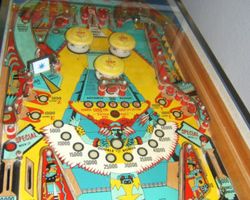
Average Prices: USD $200 to $800
Produced: Febuary, 1976
Production Run: 10,150 units
Machine Type: Electro-mechanical
Players: 4
Design by: Gordon Horlick
Williams Electronics, Incorporated, in February 1976, released "Aztec," an electro-mechanical (EM) pinball machine that would ultimately produce 10,150 units. This substantial production run solidifies its place as a widely distributed title from the twilight of the EM era. "Aztec" emerged as Williams was transitioning towards solid-state technology, making it a significant representation of the company's mastery of mechanical pinball design before the paradigm shift.
The machine’s design was led by Gordon Horlick, a name confirmed by Barry Oursler, a prolific designer himself who worked extensively on Williams' EM games during that period. Oursler's insights, gleaned from schematic initials (G.H. for Gordon Horlick, D.C. for Don Curnew on schematics, B.O. for Barry Oursler as game tech, and A.V. for Al Voight as draftsman), underscore Horlick's primary role. Oursler himself was deeply involved in the production process, from building whitewoods and wiring to drawing cables and overseeing assembly, ensuring the integrity of the design through to manufacturing. This collaborative yet distinct division of labor was typical for Williams in the 1970s. The thematic inspiration for "Aztec" stemmed from a visual source: the backglass artwork appears to draw from drawings found in the 1955 "National Geographic on Indians of the Americas: a Color-Illustrated Record." This visual connection grounded the machine's aesthetic in a recognized, albeit broadly interpreted, historical context. The initial sample run of 207 units began shipping on February 10, 1976, quickly followed by the main production phase, which ran in two distinct periods from February to May and then from July to November of 1976.
Signature Features and Design
"Aztec" is characterized by its emphasis on raw speed and direct shot-making, a hallmark of many Williams EM designs. Its playfield incorporates two powerful flippers, three DC pop bumpers, and two DC slingshots, all contributing to the machine’s dynamic and often frantic pace. A distinctive element is the single spinning target, which when lit, offers rewarding scoring opportunities. The six standup targets are strategically placed, some offering high-risk, high-reward propositions. A notable defensive feature is the upper right kickback lane, providing a chance to save a draining ball or score bonus points if activated by a skill shot. The artwork, a vibrant example of 1970s pinball aesthetics, is generally well-regarded, depicting a colorful, stylized interpretation of its namesake theme. While some find the "Williams chime" sound system to be simplistic, it provides an auditory signature that complements the mechanical action, underscoring the era's technological capabilities. These features collectively deliver a straightforward yet engaging pinball experience, focusing on shot precision and ball control.
Playfield and Mechanics
The "Aztec" playfield presents a layout that, while appearing direct, offers a surprising depth of interaction. Its non-symmetrical design maximizes the available space, providing multiple targets and pathways for the ball. Central to the gameplay is the large center target and lane, which is crucial for achieving extra balls and progressing through game objectives. Hitting this target requires precise aim; a slight miscalculation often results in an immediate outlane drain, creating a high-stakes scenario. Flanking the lower playfield are two powerful DC slingshots, which, while adding to the game's speed, can sometimes make the adjacent side stand-up targets feel less challenging as the ball is ricocheted with force.
Higher up, three potent DC pop bumpers dominate the mid-playfield, responsible for much of the machine's "screaming fast" reputation. Their powerful action keeps the ball in rapid motion, demanding quick reflexes from the player. The sole spinning target, typically illuminated during specific game phases, offers a satisfying auditory and tactile reward when struck, allowing players to "clobber" it for points. A key strategic element is the upper right kickback lane, which doubles as a bonus scoring lane. Reaching this area reliably requires a skilled shot, and successful execution often sets up significant end-of-ball bonus points. Visually, the playfield is adorned with the characteristic "classic 70s" artwork, blending vibrant colors with detailed illustrations that reinforce the Aztec theme. While the machine might appear "dark" in a typical game room due to fewer lamps compared to later solid-state games, its aesthetic is cohesive and well-executed for its time, creating an immersive, albeit straightforward, playing environment.
Gameplay Dynamics
The gameplay of "Aztec" is defined by its exhilarating speed and demanding shot accuracy. The powerful combination of DC pop bumpers and robust flippers propels the ball across the playfield with a velocity that keeps players engaged and on edge. The primary objective, universally recognized as the machine's central challenge, is to spell out "AZTEC" by hitting all the corresponding letter targets scattered across the playfield. This task is more difficult than it sounds, requiring a series of precise shots amidst the chaotic ball movement. Each successfully lit letter brings the player closer to significant scoring opportunities and possibly an extra ball, providing clear progression throughout the game.
Scoring in "Aztec" rewards a variety of shots and strategic plays. Beyond spelling "AZTEC," players aim to accumulate bonus points, which are tallied at the end of each ball. The upper right kickback lane, for instance, is not only a defensive save but also a gateway to boosting the end-of-ball bonus, making it a critical shot for high scores. The center target, while risky, offers pathways to extra balls, extending gameplay and increasing potential points. Despite its seemingly simple ruleset, the machine’s inherent challenge—especially for novice players—lies in its unforgiving outlanes, which are often described as "greedy" or "mean-spirited," leading to short average play times for those unaccustomed to its pace. The ability to "clobber" the lit spinner with strong flipper shots offers a satisfying, high-scoring reward, encouraging aggressive play when the opportunity arises. The core loop of building bonus, earning extra balls, and completing the "AZTEC" spelling provides a compelling and repeatable gameplay experience.
Reception and Legacy
"Aztec" garners largely positive reception within the pinball community, often described as a "classic" and a "keeper" that prompts players to return for another game. Its primary appeal stems from its fast-paced nature, a characteristic frequently highlighted by players who enjoy the challenge presented by its powerful DC pop bumpers and strong flippers. The objective of spelling "AZTEC" is consistently praised for its difficulty, contributing significantly to the game's replayability and providing a clear, engaging goal. The machine’s artwork, with its "classic 70s" aesthetic, is generally well-liked and contributes to its overall charm. For many, "Aztec" represents an accessible entry point into collecting electro-mechanical machines, often found at a reasonable price, making it a viable first EM game for new enthusiasts.
However, feedback also points to specific aspects that some players find less ideal. While speed is a strength, the power of the slingshots can, for some, make the side stand-up targets too easy to hit, inadvertently reducing the strategic depth in those areas. Conversely, the central "Aztec lane," while critical for objectives, is sometimes deemed "absurdly easy" to hit, contrasting with the high-risk nature of the center target itself. The "Williams chime" sound system, though characteristic of the era, receives mixed reviews, with some finding it "cheap sounding" compared to more elaborate audio designs. The machine's lower lamp count can make it appear "dark" in a game room, a minor aesthetic point. Despite these criticisms, which are often subjective preferences, "Aztec" maintains a strong reputation for its direct, challenging, and fast-moving gameplay. Its significance lies in its position as a high-production EM game from Williams just before the solid-state revolution, showcasing the pinnacle of mechanical design and contributing to the diverse tapestry of pinball history with its distinct gameplay identity.
Sponsored Links
 Ebay Listings
Ebay Listings
 Auction Results
Auction Results
| Cost | Location | Date |
|---|---|---|
| AUD $2,900 |  New South Wales, Australia New South Wales, Australia |
06 May, 2025 |
| USD $425 |  Maryland, United States Maryland, United States |
28 March, 2024 |
| USD $2,895 |  Ohio, United States Ohio, United States |
21 March, 2024 |
| USD $2,895 |  Ohio, United States Ohio, United States |
13 March, 2024 |
| USD $475 |  Florida, United States Florida, United States |
02 December, 2023 |
| USD $475 |  Florida, United States Florida, United States |
02 December, 2023 |
| USD $545 |  United States United States |
12 October, 2023 |
| EUR €1,950 |  Nordrhein-Westfalen, Germany Nordrhein-Westfalen, Germany |
02 June, 2023 |
| USD $1,450 |  United States United States |
19 December, 2022 |
| EUR €895 |  Bayern, Germany Bayern, Germany |
16 September, 2022 |


Private Policy · Search Website · Contact Us
As an eBay Partner, we may earn a commission from qualifying purchases made through links on this site, at no additional cost to you.
All trademarks and copyrighted materials remain property of their respective owners. All other content copyright 2007 - 2025 Pinpedia.

